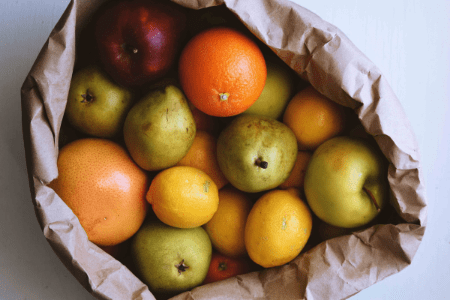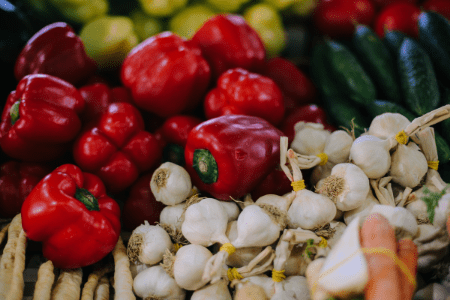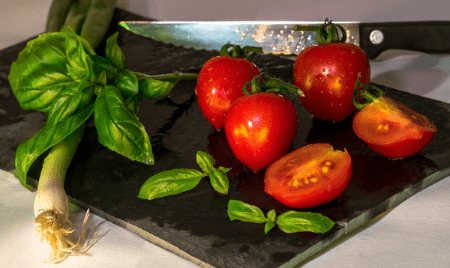Ultimate Cooking Guide by Roger Keyserling (no david read aloud TXT) 📖

- Author: Roger Keyserling
Book online «Ultimate Cooking Guide by Roger Keyserling (no david read aloud TXT) 📖». Author Roger Keyserling
If it smells ripe, sweet, and you can tell what kind of fruit it is even with your eyes closed, then that fruit should go home with you ASAP. If you smell a piece of fruit and you get a faint to the nonexistent aroma, put it back on the stack.
Alas, this trick works only at farmer's markets since refrigeration in supermarkets checks the development of aroma.
 For avocados, nectarines, plums, peaches, apricots, mangos, kiwis, and other fruits that need to have a little give in order to be flavorful, you can use the face test. If you gently squeeze the fruit in question and it feels as soft as your cheek, it's past its prime. If it feels as solid as your forehead, it's not ripe. If it feels like the end of your nose where the cartilage is, it's ripe. For many fruits, color indicates if they are ready to be eaten. As the acids within the fruit turn to sugar, the green chlorophyll breaks down and reveals the bright color underneath. Berries turn redder or bluer, bananas become bright-yellow, and apples reveal their blush. Rich, vibrant color tells you that the fruit is ripe enough to eat especially if that color happens in conjunction with the other factors mentioned above. Don't be afraid of fruit with discolorations, black dots, and brown spots.
For avocados, nectarines, plums, peaches, apricots, mangos, kiwis, and other fruits that need to have a little give in order to be flavorful, you can use the face test. If you gently squeeze the fruit in question and it feels as soft as your cheek, it's past its prime. If it feels as solid as your forehead, it's not ripe. If it feels like the end of your nose where the cartilage is, it's ripe. For many fruits, color indicates if they are ready to be eaten. As the acids within the fruit turn to sugar, the green chlorophyll breaks down and reveals the bright color underneath. Berries turn redder or bluer, bananas become bright-yellow, and apples reveal their blush. Rich, vibrant color tells you that the fruit is ripe enough to eat especially if that color happens in conjunction with the other factors mentioned above. Don't be afraid of fruit with discolorations, black dots, and brown spots.
On many fruits, the black spots are signs that bees have been at it, which is a good thing since they head for the sweetest, ripest fruit.
He says that some of the best eating oranges and mandarins bear those marks and tend to have skin defects and also make a point of buying "Ugly" or misshapen fruit as well. Most markets reject those fruits since they fear consumers won't buy them. If you live near an Asian market, check out their produce aisles, since they will stock those fruits. Some markets will stock "Uglier" fruit and put it on markdown, so be sure to investigate those bins before moving on. As for brown spots, many shoppers fear that they're signs of rot, but produce workers know that on many fruits, like pears, they're actually signs that the fruit is ready for eating. Like the passion fruit and Satsuma mandarin, are riper the more wrinkles they get. Kent mangoes should also develop some wrinkles and be "Suspiciously soft" before they're ripe enough to eat. Everett advises that you pass up really gigantic fruit since it usually indicates that it's been grown out of season.I personally rely on a combination of smell and touch to tell when most melons are ripe: sniff the stem end of the melon, and while you're at it, press on the area around the stem. It should have some give, which indicates the melon was picked when it was ripe and came easily off the vine. As for the thump test, hold the watermelon in one hand and give it a good thwack with the other.
It's also good to know what fruits continue to ripen after picking, which will get sweeter in taste, which will change color but not in sweetness, and which won't ripen after picking at all
One tried and true ripeness test is to judge based on the size of the vegetable or fruit compared with others of the same type. Smaller than average? It was likely harvested too early and won’t ripen adequately. If it’s dramatically bigger–think zucchini–it was left on the plant too long and will be bland or tough and fibrous. A heavier fruit likely has higher water content and will be juicier than a lighter one of similar size, and certain fruits, such as limes, should be heavier than you expect them to be.
Choosing the ripest, freshest, and most delicious produce in your supermarket is not like finding a needle in a haystack if just know the values of sniffing, squeezing or thumping.
 How to Store Your Veggies
How to Store Your Veggies
The next time you rearrange the fridge to make room for your produce haul, move fruits like apples and pears as far away from the veggies as possible. As they ripen, these fruits release ethylene gas, which can cause nearby veggies to yellow and spoil
Broccoli
How to store it Place the head of broccoli in a ventilated bag (such as a perforated one or a plastic bag with the top left open) and keep in the refrigerator.
How long it lasts Three to five daysCarrots
How to store them
Place whole carrots in a ventilated bag with a damp paper towel, which keeps veggies from drying out. Store baby carrots in the baggie they come in.
How long they last Whole carrots: two to three weeks; baby carrots: about a month. (A whitish color on baby carrots is a sign they’ve lost moisture. They’re still safe to eat; just rehydrate the sticks by placing them in water for a few minutes.)
CauliflowerHow to store it Wraps the cauliflower in a dampened paper towel, then place it in a plastic bag in the fridge.
How long it lasts Three to five days
Cucumber
How to store it Refrigerate the cucumber in a ventilated bag.
How long it lasts Four to six days
Leafy greens, like lettuce and spinach how to store them Store in a clean plastic bag with a few paper towels to soak up any excess moisture that can lead to sogginess. Then place in the crisper drawer.
How long they last Three to five days
TomatoesHow to store them Yes, technically a fruit…but nonetheless, keep whole tomatoes, including baby tomatoes and those that are on the vine, out of the fridge (they lose firmness and flavor when chilled). Once you slice them up, store tomatoes (and any other cut up veggies) in a closed container in the fridge. “This prevents them from drying out and also from taking on the flavors of other foods,” says Garden-Robinson.
How long they last Whole tomatoes: five to seven days outside of the fridge; sliced tomatoes: two to three days in the fridge.
 mushrooms how to store them If the container they came in has holes for ventilation, you can keep the mushrooms in that. If not, place in a paper bag, then refrigerate. (FYI, mushrooms that are stored in plastic bags will become slimy.)
mushrooms how to store them If the container they came in has holes for ventilation, you can keep the mushrooms in that. If not, place in a paper bag, then refrigerate. (FYI, mushrooms that are stored in plastic bags will become slimy.)
How long they last Three to seven days
PeppersHow to store them Place the veggies in the fridge—no bag needed.
How long they last Four days to two weeks
ZucchiniHow to store it As with cucumbers, you can keep zucchini in a plastic bag in the fridge.
How long it lasts Three to five days
How to Tell If Produce Is Past Its Prime
If you forget to use up a bunch of lettuce or head of cauliflower in time (hey, it happens), check out the food’s color, texture, and aroma to determine if it’s okay to eat. If you just see a few wrinkles on veggies like carrots, celery stalks, or peppers, keep ‘em. These can still be used in soups and other cooked dishes. But if the item is slimy, discolored, smells off or–gag!—you spot mold, toss it, says Garden-Robinson. Definitely not worth getting sick over.
More Tips
I don't know about you, but I'm not a calm cook, so be organized before you start. If you master the above step, cooking will feel like a breeze and will be much more enjoyable. Potatoes in the oven won't be as crisp on the outside, the meat won't brown as well, either. so you can shear meat easily enough before the use of the oven. Get in the habit of turning your cooking pot handles to the side and stay safe, cooks and kids! A chef's knife can also be called a cook's knife, the grade of the knife sometimes is the variation. I have noticed when I buy organic foods and better quality meats, they taste better. If you've made the meal enough times, you know at what points in the cooking process you can bend the rules and try new things. When you put meat into a cold pan, the meat is going to release moisture as it heats up. Unless you like gnawing on dry meat, heat your pan up first so your moisture stays in the meat and doesn't escape too early. If the meat has moisture on the surface, it doesn't brown as well. When the meat is cooked, moisture moves outward towards the edges of the meat. When sautéing garlic, use sliced garlic instead of minced to prevent burning. Invest in a seasoned cast iron skillet. This kitchen staple distributes heat evenly and is easy to clean. Remove tough stems on leafy greens by pinching the stem and gently pulling off the leaves with your other hand. If your recipe calls for buttermilk, you can use regular milk with lemon juice. Prepping salad before serving is a huge time saver. Layer all the ingredients in a bowl and don’t add the dressing until it's time to serve. Keep your spices away from sources of heat like the stove or lights. Herbs and spices can lose their flavor when exposed to humidity and heat. Save old, stale bread to make breadcrumbs in a food processor; you can freeze them for up to 6 months. Let steaks come to room temperature before seasoning and grilling. Store fresh herbs in a glass of water in your refrigerator. To prevent tears, cut off the root of the onion before you slice. For crispy fries or chips: slice the potato, then remove the starch by soaking in water for one hour before baking. Celery getting floppy? Try wrapping it in tin foil before storing in the refrigerator. Soften up hard brown sugar by placing a piece of dry bread in the bag overnight. Roll citrus on the counter using the palm of your hand to help release all of the juice pockets. Kitchen Pantry Essentials: Olive Oil, Flour, Broth, Salt, Brown Rice or Pasta, Beans, Vinegar, Sugar, Eggs, Soy Sauce Increase the shelf life of a halved avocado by keeping the pit intact and placing it in your refrigerator. To prevent sliced apples from browning, lightly squeeze lemon or lime juice on the pieces. You can store butter in the freezer for up to six months. Honey is a natural preservative and will never spoil. To last longer, opened flour bags can be stored in the freezer. If you think you're going to be cooking more than one meal in your lifetime, it's worth it to invest in a set of measuring spoons and a very good knife. If you fail at a meal, congratulations! That means you're one step closer to becoming a better cook. You can never be a good cook without some serious flops. Everything Cooking Related At Keywebco Set up the perfect workspace by gathering clean tools, bowls, and utensils. And make sure to keep a trashcan within arm’s reach. To create an egg wash, whisk together a large egg with one tablespoon of water until smooth. Use as a glue to seal pastries, then brush on top for a glossy appearance. Peel tomatoes with ease! Cut an X in the top, and then simmer in a pot of hot water for 15 to 30 seconds. Cooldown and the skin will fall right off. Get comfortable! Wear comfy clothes and an apron when you work in the kitchen and you won’t have to worry about getting dirty. Invest in a baking scale. Scales are not only an accurate way to measure your cooking ingredients, but they streamline the entire process. Always read and re-read your recipes before you start cooking. Clean as you go! Use two skewers instead of one when grilling or roasting to prevent your food from spinning. Learn and practice the rule of thumb to check the readiness of steak. To prevent the butter from over-browning in your pan, add





Comments (0)